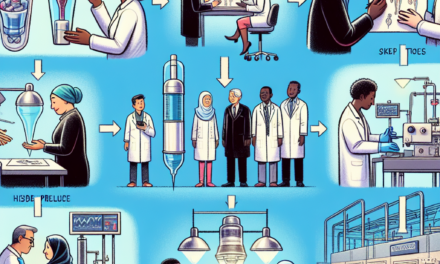Preventing Contamination: The Role of Hygiene in Safeguarding Healthcare Facilities
In the realm of healthcare, the importance of hygiene cannot be overstated. Contamination in healthcare facilities can lead to severe consequences, including healthcare-associated infections (HAIs), increased patient morbidity and mortality, and significant financial burdens on healthcare systems. This article delves into the critical role of hygiene in preventing contamination, exploring various aspects such as the significance of hand hygiene, environmental cleaning, sterilization processes, staff training, and the impact of technology in maintaining hygiene standards.
The Significance of Hand Hygiene
Hand hygiene is the cornerstone of infection prevention in healthcare settings. The World Health Organization (WHO) emphasizes that proper hand hygiene can reduce the transmission of pathogens and significantly lower the incidence of HAIs.
Understanding the Importance of Hand Hygiene
Hands are the primary vehicles for the transmission of pathogens in healthcare environments. Healthcare workers (HCWs) frequently come into contact with patients, medical equipment, and surfaces that may harbor infectious agents. According to the Centers for Disease Control and Prevention (CDC), approximately 1 in 31 hospital patients has at least one HAI on any given day, highlighting the critical need for effective hand hygiene practices.
Best Practices for Hand Hygiene
To ensure effective hand hygiene, healthcare facilities should implement the following best practices:
- Regular Handwashing: HCWs should wash their hands with soap and water for at least 20 seconds, especially after contact with patients or contaminated surfaces.
- Use of Alcohol-Based Hand Sanitizers: When soap and water are not available, alcohol-based hand sanitizers with at least 60% alcohol should be used.
- Hand Hygiene Audits: Regular audits can help monitor compliance with hand hygiene protocols and identify areas for improvement.
Challenges in Hand Hygiene Compliance
Despite the clear benefits of hand hygiene, compliance rates among HCWs remain suboptimal. A systematic review published in the Journal of Hospital Infection found that compliance rates often fall below 50%. Factors contributing to low compliance include:
- Time Constraints: HCWs often face heavy workloads, leading to rushed interactions with patients.
- Lack of Accessibility: Insufficient handwashing stations or hand sanitizer dispensers can hinder compliance.
- Inadequate Training: Some HCWs may not fully understand the importance of hand hygiene or the correct techniques.
Case Study: Improving Hand Hygiene Compliance
A notable case study from a large urban hospital demonstrated the effectiveness of a comprehensive hand hygiene program. The hospital implemented a multi-faceted approach that included:
- Education and training sessions for all staff on the importance of hand hygiene.
- Installation of additional hand sanitizer dispensers throughout the facility.
- Regular feedback and reminders to staff regarding hand hygiene compliance.
As a result, the hospital reported a 30% increase in hand hygiene compliance over six months, leading to a significant reduction in HAIs.
Environmental Cleaning: A Critical Component
Environmental cleaning is another vital aspect of infection prevention in healthcare facilities. Contaminated surfaces can serve as reservoirs for pathogens, making effective cleaning protocols essential.
The Role of Environmental Cleaning in Infection Control
Studies have shown that contaminated surfaces can contribute to the transmission of infections. For instance, a study published in the American Journal of Infection Control found that high-touch surfaces in patient rooms, such as bed rails and doorknobs, were frequently contaminated with pathogens like MRSA and C. difficile.
Best Practices for Environmental Cleaning
To maintain a clean and safe environment, healthcare facilities should adopt the following cleaning practices:
- Routine Cleaning Protocols: Establishing regular cleaning schedules for all areas, especially high-touch surfaces, is crucial.
- Use of EPA-Registered Disinfectants: Cleaning products should be effective against a broad spectrum of pathogens.
- Training for Cleaning Staff: Ensuring that cleaning staff are trained in proper cleaning techniques and the importance of their role in infection prevention.
Challenges in Environmental Cleaning
Despite the importance of environmental cleaning, several challenges can hinder effective practices:
- Resource Limitations: Budget constraints may limit the availability of cleaning supplies and staff.
- Inconsistent Protocols: Variability in cleaning practices among staff can lead to gaps in infection control.
- Lack of Awareness: Some healthcare workers may underestimate the role of environmental cleaning in preventing infections.
Case Study: Enhancing Environmental Cleaning Practices
A study conducted in a long-term care facility highlighted the impact of enhanced environmental cleaning protocols. The facility implemented a comprehensive cleaning program that included:
- Daily cleaning of high-touch surfaces with EPA-approved disinfectants.
- Regular training sessions for cleaning staff on infection control practices.
- Monitoring and feedback mechanisms to ensure adherence to cleaning protocols.
As a result, the facility observed a 40% reduction in HAIs over a one-year period, demonstrating the effectiveness of rigorous environmental cleaning practices.
Sterilization Processes: Ensuring Safety in Medical Procedures
Sterilization is a critical process in healthcare that ensures medical instruments and devices are free from all microorganisms. This is particularly important in surgical settings where the risk of infection is heightened.
The Importance of Sterilization
Inadequate sterilization can lead to serious complications, including surgical site infections (SSIs). According to the CDC, SSIs account for 31% of all HAIs, underscoring the need for stringent sterilization protocols.
Types of Sterilization Methods
Healthcare facilities utilize various sterilization methods, including:
- Steam Sterilization (Autoclaving): This method uses high-pressure steam to kill microorganisms and is effective for most surgical instruments.
- Ethylene Oxide Sterilization: This gas sterilization method is suitable for heat-sensitive instruments.
- Hydrogen Peroxide Plasma Sterilization: This method is effective for delicate instruments and provides rapid sterilization.
Best Practices for Sterilization
To ensure effective sterilization, healthcare facilities should implement the following best practices:
- Regular Maintenance of Sterilization Equipment: Ensuring that autoclaves and other sterilization devices are regularly serviced and calibrated.
- Monitoring Sterilization Processes: Utilizing biological indicators to verify the effectiveness of sterilization cycles.
- Training for Staff: Providing comprehensive training for staff on sterilization protocols and the importance of adherence.
Challenges in Sterilization Compliance
Despite the critical nature of sterilization, several challenges can impede compliance:
- Inadequate Training: Staff may not be fully trained on sterilization protocols, leading to errors.
- Resource Constraints: Limited access to sterilization equipment can hinder timely procedures.
- Lack of Standardization: Variability in sterilization practices across departments can lead to inconsistencies.
Case Study: Improving Sterilization Practices
A case study from a surgical center demonstrated the impact of enhanced sterilization protocols. The center implemented a quality improvement initiative that included:
- Standardizing sterilization procedures across all surgical teams.
- Regular training sessions on the importance of sterilization and monitoring compliance.
- Utilizing biological indicators to verify sterilization effectiveness.
As a result, the center reported a significant decrease in SSIs, reinforcing the importance of rigorous sterilization practices.
Staff Training and Education: Building a Culture of Hygiene
Effective hygiene practices in healthcare facilities rely heavily on the knowledge and behavior of staff. Continuous training and education are essential to foster a culture of hygiene and infection prevention.
The Importance of Staff Training
Training programs that emphasize the importance of hygiene can lead to improved compliance with infection control protocols. A study published in the Journal of Hospital Infection found that targeted training interventions significantly increased hand hygiene compliance among HCWs.
Components of Effective Training Programs
Healthcare facilities should consider the following components when developing training programs:
- Comprehensive Curriculum: Training should cover all aspects of hygiene, including hand hygiene, environmental cleaning, and sterilization.
- Interactive Learning: Utilizing simulations and role-playing can enhance engagement and retention of information.
- Regular Refresher Courses: Ongoing education is crucial to reinforce knowledge and address any emerging challenges.
Challenges in Staff Training
Despite the importance of training, several challenges can hinder effective implementation:
- Time Constraints: HCWs often have demanding schedules, making it difficult to allocate time for training.
- Lack of Resources: Limited funding may restrict the availability of training materials and programs.
- Resistance to Change: Some staff may be resistant to adopting new practices or protocols.
Case Study: Successful Staff Training Initiatives
A case study from a community hospital highlighted the effectiveness of a comprehensive staff training program. The hospital implemented a multi-faceted approach that included:
- Regular training sessions on infection control practices for all staff members.
- Utilizing visual aids and reminders throughout the facility to reinforce hygiene protocols.
- Incentives for departments that achieved high compliance rates with hygiene practices.
As a result, the hospital reported a significant increase in hand hygiene compliance and a corresponding decrease in HAIs.
The Impact of Technology on Hygiene Practices
Advancements in technology have revolutionized hygiene practices in healthcare facilities. From automated cleaning systems to electronic monitoring of hand hygiene compliance, technology plays a crucial role in enhancing infection prevention efforts.
Innovative Technologies in Environmental Cleaning
Automated cleaning systems, such as ultraviolet (UV) disinfection robots, have gained popularity in healthcare settings. These systems utilize UV light to kill pathogens on surfaces, providing an additional layer of protection against contamination.
Electronic Monitoring Systems for Hand Hygiene Compliance
Electronic monitoring systems can track hand hygiene compliance in real-time, providing valuable data for healthcare facilities. These systems can alert staff when hand hygiene opportunities are missed, promoting accountability and adherence to protocols.
Telehealth and Hygiene Practices
The rise of telehealth has also impacted hygiene practices. By reducing the need for in-person visits, telehealth can minimize the risk of contamination in healthcare facilities. However, it is essential to maintain hygiene standards in virtual interactions, ensuring that HCWs follow proper protocols when handling equipment and patient information.
Challenges in Implementing Technology
While technology offers numerous benefits, several challenges can hinder its implementation:
- Cost Considerations: The initial investment in technology can be a barrier for some healthcare facilities.
- Staff Training: Ensuring that staff are adequately trained to use new technologies is essential for success.
- Integration with Existing Systems: New technologies must be compatible with existing workflows and systems to be effective.
Case Study: Technology-Driven Hygiene Improvements
A case study from a large academic medical center demonstrated the impact of technology on hygiene practices. The center implemented an electronic monitoring system for hand hygiene compliance, which included:
- Real-time feedback for staff on their hand hygiene practices.
- Data analytics to identify trends and areas for improvement.
- Integration with training programs to reinforce compliance.
As a result, the center reported a 25% increase in hand hygiene compliance and a corresponding decrease in HAIs, showcasing the potential of technology in enhancing hygiene practices.
Conclusion: The Imperative of Hygiene in Healthcare Facilities
Preventing contamination in healthcare facilities is a multifaceted challenge that requires a comprehensive approach to hygiene. From hand hygiene and environmental cleaning to sterilization processes and staff training, each component plays a vital role in safeguarding patient health. The integration of technology further enhances these efforts, providing innovative solutions to improve compliance and reduce the risk of infections.
As healthcare facilities continue to navigate the complexities of infection prevention, it is essential to prioritize hygiene as a fundamental aspect of patient care. By fostering a culture of hygiene and investing in effective practices, healthcare organizations can significantly reduce the incidence of HAIs, ultimately improving patient outcomes and enhancing the overall quality of care.
In summary, the role of hygiene in preventing contamination cannot be underestimated. It is a shared responsibility among all healthcare stakeholders, and through collaboration, education, and innovation, we can create safer healthcare environments for all.





